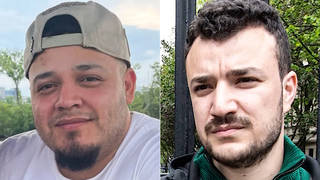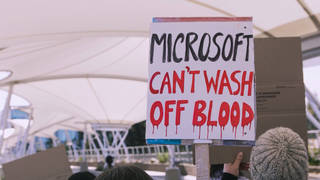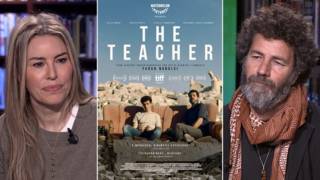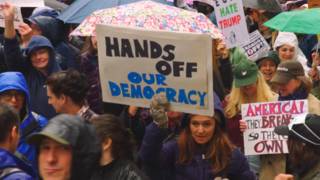
As Hurricane Ivan slams into the U.S. Gulf Coast with devastating winds and pounding waves, we go to New Orleans–which narrowly avoided a catastrophe–to speak with Pulitzer prize-winning environmental reporter Mark Schleifstein and David Helvarg of the Blue Frontier Campaign. [includes rush transcript]
Hurricane Ivan slammed into the Gulf Coast early today with devastating winds and pounding waves that ripped homes apart, destroyed power lines and flooded deep inland.
After a deadly rampage across the Caribbean and the Gulf of Mexico that left 68 people dead, Hurricane Ivan made landfall near the town of Gulf Shores, Alabama, at about 3:00am Eastern Time this morning.
But the storm, which is the size of Texas, was felt over a huge stretch of the coast and inland in Alabama, Mississippi, Louisiana and Florida where nearly two million residents were ordered to evacuate their homes. Thousands of people huddled in shelters and hundreds of thousands were left without power.
Hours before Ivan came ashore, its outer edges spawned tornadoes blamed for the deaths of two people in Panama City Beach, Florida.
But it is New Orleans–the largest US city below sea level–that is particularly vulnerable to flooding. The city’s emergency manager yesterday warned that as many as 50,000 people could drown if New Orleans was hit by a strong Category 4 storm. The city has 10,000 body bags on hand in case of a catastrophe.
While many New Orleans residents took city officials’ advice and left town, a large group of people, mostly concentrated in poorer neighborhoods didn’t have a choice but to stay and hope for the best. With no public transportation or evacuation plan, up to 100,000 people were left stranded in the city.
- David Helvarg, President of the Blue Frontier Campaign and author of the books The War Against the Greens and Blue Frontier: Saving Americas Living Seas. He is also a contributor to Feeling the Heat–Reports from the Frontlines of Climate Change.
- Mark Schleifstein, Pulitzer prize-winning environmental reporter for the New Orleans Times Picayune. He joins us on the phone from his office in New Orleans where he spent the night.
Transcript
AMY GOODMAN: But we’re going to begin with David Helvarg. He is the president of the Blue Frontier Campaign, and author of the book War against the Greens, and more recently, Blue Frontiers: Saving America’s Living Seas. David Helvarg, we’re having you on again, as the storms continue another one on the horizon as well, and again raising this issue that we’re now looking at almost wall to wall weather coverage in this country, with these massive storms. Yet, and I have yet to see the words “global warming” or hear them. Your comment, what does this indicate?
DAVID HELVARG: Hi, Amy. Now this is the new normality. Even if we didn’t have the additional add-ons of fossil fuel driven climate change, we have the 25 to 40-year cycles of lesser and greater hurricane activity. And the 60’s to the 90’s was lesser activity where you average one-and-a-half landfalls per season, and now this is a new normality, three hurricane landfalls per season is what we can expect between now and about 2040, and of course, by then, nobody will be debating the added kick-in of the erosion, sea level rise and intensified storms linked to climate. But, you know, as I say, the only difference between the last period of intensified hurricanes back in the 50’s and the 60s and today is massive coastal sprawls. 17 of the 25 fastest growing counties are coastal now, and oddly, instead of taking precautions and being aware that we’re at risk from intensified Atlantic hurricanes and climate change, policy continues to support a kind of high risk coastal sprawl that both destroys the coastal environment and puts millions of people in harm’s way. We have a government report that says 25% of all houses within 500 feet of the ocean will be gone in the next 50 years. And yet we have a federal flood insurance system that drives the development. Gulf shores, which is taking the brunt of hurricane Ivan in 79 was hit by — it used to be beach shacks there. I have been the Alabama coast. It used to be lovely. In 1979, hurricane Frederick took out the beach shacks. Because the federal subsidies were there, the developers replaced them with 14 story condominiums, which are being ground up into glass shards this morning. I was down in Dolphin Island, Alabama two years ago. You have got literally hundreds of rental units on the beach, on stilts, at least you had them. They may all be gone now. It’s a strange system, and stranger still is that we’re in a state of denial. You know, we’re driving development in these high risk areas.
JUAN GONZALEZ: Well, David, about that development, clearly, as you say increasingly upper income people, are moving, having these enormous mansions and condominiums along ocean fronts and in the path of potential hurricanes and it ends up with the insurance industry and then the federal government with its disaster relief bailing out folks who are actually building in areas where they shouldn’t be. What kind of — what are the responses of the politicians to this obvious invitation to economic disaster?
DAVID HELVARG: For the most part the response is to encourage it. We now have 673 billion dollars of federally insured flood sites and half of these homes in Florida and the most expensive are in places like North Captiva, Florida, where the flood insurance program began in 1968. Then they quickly realized this was a driver of development because once you have the federal flood insurance, the banks would provide the mortgages and you had things like the transformation of Gulf shores, Alabama. So in 82, the Congress realized that this was a mistake and they excluded over a million acres of barrier islands which we probably should change their name to “death by drowning” islands, since people don’t really understand what the barriers are against. Over a million acres were excluded. And since the 104th Congress, since the Gingrich Congress, they’ve been proposing to Congressmen, they have been proposing technical corrections to take out acreage to allow it to get its subsidies back. One example, during the first of these, during the hurricane Charlie, North Captiva, became the north, and far North Captiva, it was broken up by Charlie, about a quarter of the island was excluded from subsidies until 99 when Porter Goss, who is now up for C.I.A. Director, came in with the technical direction two days before the Thanks Giving break. He got 200 acres of North Captiva back into the federal flood insurance system so — there have been some 50 structures built since then, and we don’t know how much — we don’t know until we have done the damage assessments, how many millions of tax dollars, how many family farmers in Iowa are going to be paying to rebuild the second home estates in North Captiva, the richest coast in America.
AMY GOODMAN: David Helvarg, we are also joined by Mark Schleifstein, who is a Pulitzer Prize winning environmental reporter for the New Orleans Times Picayune. He joins us on the phone from his office in New Orleans where he spent the night. Welcome to Democracy Now!
MARK SCHLEIFSTEIN: Good morning. Good morning.
AMY GOODMAN: It’s good to have you with us. Well, in one sense, it is a good morning for you, in New Orleans, it looks like hurricane Ivan has crashed onto the shore in Alabama, not New Orleans.
MARK SCHLEIFSTEIN: Right. We’re — I’m sure that as we move out this morning to take a look around, there’s going to be some minor damage in the city itself, and maybe some more extensive damage south of us along the Louisiana coastline on the east side of the Mississippi river, but for us, we — you know this was not the big one. So to speak. It did what hurricane George did in 1998, and at the last minute, it moved to the east enough to spare us from catastrophic storm surge.
JUAN GONZALEZ: Yeah. Mark, your newspaper had a story yesterday about the advice of officials to many residents in New Orleans to move out of the storm’s path, but yet there was the problem of up to 100,000 poor New Orleans who could not — New Orleans residents who could not evacuate because they didn’t own cars. Could you talk about that story and what happened?
MARK SCHLEIFSTEIN: Sure. Fortunately, like I said, things weren’t horrendous. That became a semi-non-problem this time. But it’s the elephant in the room in Louisiana. What is going to happen when the worst case scenario hits, and there are all of these people who cannot get out? There are — there’s talk about some grand plan for moving people to some sort of structure that was — that would provide them with at least a refuge. The mayor of New Orleans yesterday opened up the super dome to act as that refuge, and fortunately, a few people took advantage of it. I think there were 1,200 people who did. In the two-hour period that they were allowed to make that decision, get to a staging area, and be bussed to the superdome and allowed in. When there really is a serious one, I think you’ll see a rush of buses to get people to a variety of different structures with the explanation that this is a refuge, not a shelter, and there is nothing there for you. You have to bring everything yourself. And it is going to be a disaster. Engineers have gone through the city, building engineers, civil engineers have done a survey of the city and basically found that there are no public buildings with enough areas that would survive a catastrophic storm to actually act as refuges even in the city. There’s no effort yet to require new public buildings to withstand catastrophic hurricane winds.
AMY GOODMAN: Mark, very quickly, we were just commenting at the top of this segment that there’s a tremendous amount of coverage obviously on these monster hurricanes, but we rather hear the words “global warming” in all of the weather coverage. Actually, the British Prime Minister Tony Blair yesterday said urgent action is needed to combat the world’s greatest environmental challenge, but in this country, it’s almost a concept, people don’t know about it if they just get their information from the media.
MARK SCHLEIFSTEIN: Well, I’m —
AMY GOODMAN: As an environmental reporter, do you deal with this, at the Times Picayune?
MARK SCHLEIFSTEIN: I’m not quite sure that’s quite as rough as the way you’re painting it. I know that in my newspaper, we have quite a few stories that deal with global warming — global climate change, some of which are directly aimed at the concern here in Louisiana. We have serious concerns about changes in our climate causing significant changes in the way we live. There’s significant concerns about increased vectors being created by warmer and wetter weather here, and you know, everything from return of malaria and yellow fever to newer diseases that may be popping in to the community, and of course, there are — our biggest problem here in Louisiana is sea level rise. You know, I — sadly, the joke here is that we don’t have to wait for the additional sea level rise from climate change to cause problems for us. Our coastline is already in drastic danger. We are losing communities to sea level rise today. Not in 25 years or 50 years or 100 years. It’s happening now.
AMY GOODMAN: Mark Schleifstein on that note, I want to thank you for being with us. Mark Schleifstein is a Pulitzer Prize winner reporter for the Times Picayune. The environmentalist stayed in his office last night preparing for hurricane Ivan. David Helvarg, president of the Blue Frontier Campaign.












Media Options